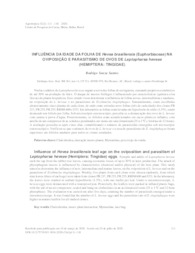Influência da idade da folha de Hevea brasiliensis (Euphorbiaceae) na oviposição e parasitismo de ovos de Leptopharsa heveae (Hemiptera: Tingidae).
Influência da idade da folha de Hevea brasiliensis (Euphorbiaceae) na oviposição e parasitismo de ovos de Leptopharsa heveae (Hemiptera: Tingidae).
Author(s): SANTOS, R. S.
Summary: Ninfas e adultos de Leptopharsa heveae sugam a seiva das folhas de seringueira, causando prejuízos econômicos de até 30% na produção de látex. O ataque de insetos fitófagos é influenciado por características (química e/ou físicas) da planta hospedeira. Esse estudo visou determinar a influência de folhas novas, intermediárias e maduras, na oviposição de L. heveae e no parasitismo de Erythmelus tingitiphagus. Semanalmente, eram escolhidas aleatoriamente cinco plantas de cada clone, de onde eram retiradas nove folhas (três de cada idade) dos clones PB 217, PB 235, PR 255, RRIM 600 e GT1. Em laboratório as folhas eram lavadas em hipoclorito de sódio (1,5%), sendo destacado um folíolo por folha. Sob microscópio estereoscópio, procedia-se a demarcação dos ovos de L. heveae com caneta à prova d?água. Posteriormente, os folíolos eram acondicionados em sacos plásticos inflados, com auxílio de um compressor de ar, selados e pendurados em varais em sala climatizada (25 ± 1 ºC e fotofase de 12 horas). A avaliação procedia-se após cinco dias, contabilizando o número de parasitoides emergidos sob microscópio estereoscópico. Verificou-se que o número de ovos de L. heveae e a taxa de parasitismo de E. tingitiphagus foram superiores em folíolos maduros para todos os clones estudados. Nymphs and adults of Leptopharsa heveae suck the sap from the rubber tree leaves, causing economic losses of up to 30% in latex production. The attack of phytophagous insects is influenced by characteristics (chemical and/or physical) of the host plant. This study aimed to determine the influence of new, intermediate and mature leaves, on the oviposition of L. heveae and on the parasitism of Erythmelus tingitiphagus. Weekly, five plants from each clone were chosen randomly, from which nine leaves (three of each age) were taken from clones PB 217, PB 235, PR 255, RRIM 600 and GT1. In the laboratory, the leaves were washed in sodium hypochlorite (1.5%), with one leaflet per leaf. Under a stereomicroscope, L. heveae eggs were demarcated with a waterproof pen. Posteriorly, the leaflets were packed in inflated plastic bags, with the aid of an air compressor, sealed and hung on clotheslines in an acclimatized room (25 ± 1 ºC and 12 hour photophase). The evaluation was carried out after five days, counting the number of parasitoids emerged under a stereomicroscope. It was found that the number of L. heveae eggs and the parasitism rate of E. tingitiphagus were higher in mature leaflets for all studied clones.
Publication year: 2020
Types of publication: Journal article
Unit: Embrapa Acre
Keywords: Arbol de goma, Chalcidoidea, Edad de la hoja, Folha, Hevea Brasiliensis, Idade, Lace bug, Leaf age, Leptopharsa heveae, Mosca de Renda, Mymaridae, Oviposición, Oviposition, Ovo, Parasitism, Parasitismo, Percevejo de Renda, Plagas de plantas, Plant pests, Plant-insect relations, Praga de Planta, Relaciones planta-insecto, Ruber tree, Seringueira
Observation
Some of Embrapa's publications are published as ePub files. To read them, use or download one of the following free software options to your computer or mobile device. Android: Google Play Books; IOS: iBooks; Windows and Linux: Calibre.
Access other publications
Access the Agricultural Research Database (BDPA) to consult Embrapa's full library collection and records.
Visit Embrapa Bookstore to purchase books and other publications sold by Embrapa.

